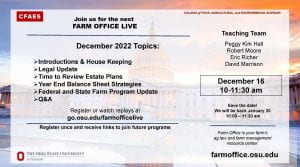By: Barry Ward, Leader, Production Business Management, OSU Extension, Agriculture and Natural Resources; John Barker, Extension Educator Agriculture/Amos Program, Ohio State University Extension Knox County and Eric Richer, Extension Educator Agriculture & Natural Resources, Ohio State University Extension Fulton County
Farming is a complex business and many Ohio farmers utilize outside assistance for specific farm-related work. This option is appealing for tasks requiring specialized equipment or technical expertise. Often, having someone else with specialized tools perform tasks is more cost effective and saves time. Farm work completed by others is often referred to as “custom farm work” or more simply, “custom work”. A “custom rate” is the amount agreed upon by both parties to be paid by the custom work customer to the custom work provider.
Ohio Farm Custom Rates
The “Ohio Farm Custom Rates 2022” publication reports custom rates based on a statewide survey of 223 farmers, custom operators, farm managers, and landowners conducted in 2022. These rates, except where noted, include the implement and tractor if required, all variable machinery costs such as fuel, oil, lube, twine, etc., and labor for the operation.
Some custom rates published in this study vary widely, possibly influenced by:
- Type or size of equipment used (e.g. 20-shank chisel plow versus a 9-shank)
- Size and shape of fields,
- Condition of the crop (for harvesting operations)
- Skill level of labor
- Amount of labor needed in relation to the equipment capabilities
- Cost margin differences for full-time custom operators compared to farmers supplementing current income
Some custom rates reflect discounted rates as the parties involved have family or community relationships, Discounted rates may also occur when the custom work provider is attempting to strengthen a relationship to help secure the custom farmed land in a future purchase, cash rental or other rental agreement. Some providers charge differently because they are simply attempting to spread their fixed costs over more acreage to decrease fixed costs per acre and are willing to forgo complete cost recovery.
New this year, the number of responses for each operation has been added to the data presented. In cases where there were too few responses to statistically analyze, summary statistics are not presented.
Charges may be added if the custom provider considers a job abnormal such as distance from the operator’s base location, difficulty of terrain, amount of product or labor involved with the operation, or other special requirements of the custom work customer.
The data from this survey are intended to show a representative farming industry cost for specified machines and operations in Ohio. As a custom farm work provider, the average rates reported in this publication may not cover your total costs for performing the custom service. As a customer, you may not be able to hire a custom service for the average rate published in this factsheet.
It is recommended that you calculate your own costs carefully before determining the custom rate to charge or pay. It may be helpful to compare the custom rates reported in this fact sheet with machinery costs calculated by economic engineering models available online. The following resources are available to help you calculate and consider the total costs of performing a given machinery operation.
Farm Machinery Cost Estimates, available by searching University of Minnesota.
Illinois Farm Management Handbook, available by searching University of Illinois farmdoc.
Estimating Farm Machinery Costs, available by searching Iowa State University agriculture decision maker and machinery management.
Fuel price changes may cause some uncertainty in setting a custom rate. Significant volatility in diesel price over the last several months has caused some concern for custom rate providers that seek to cover all or most of the costs associated with custom farm operations. The approximate price of diesel fuel during the survey period ranged from $4.50 – $5.25 per gallon for off-road (farm) usage. As a custom farm work provider, if you feel that your rate doesn’t capture your full costs due to fuel price increases you might consider a custom rate increase or fuel surcharge based on the increase in fuel costs.
For example, let’s assume the rate you planned to charge for a chisel plow operation was based on $4.50 per gallon diesel costs and the current on-farm diesel price is $5.50 per gallon. This is a $1 per gallon increase. The chisel plow operation uses 1.15 gallons of fuel per acre so the added fuel surcharge could be set at $1.15 per acre (1.15 gallons x $1 gallon).
The complete “Ohio Farm Custom Rates 2022” publication is available online at the Farm Office website:
https://farmoffice.osu.edu/farm-management/custom-rates-and-machinery-costs



